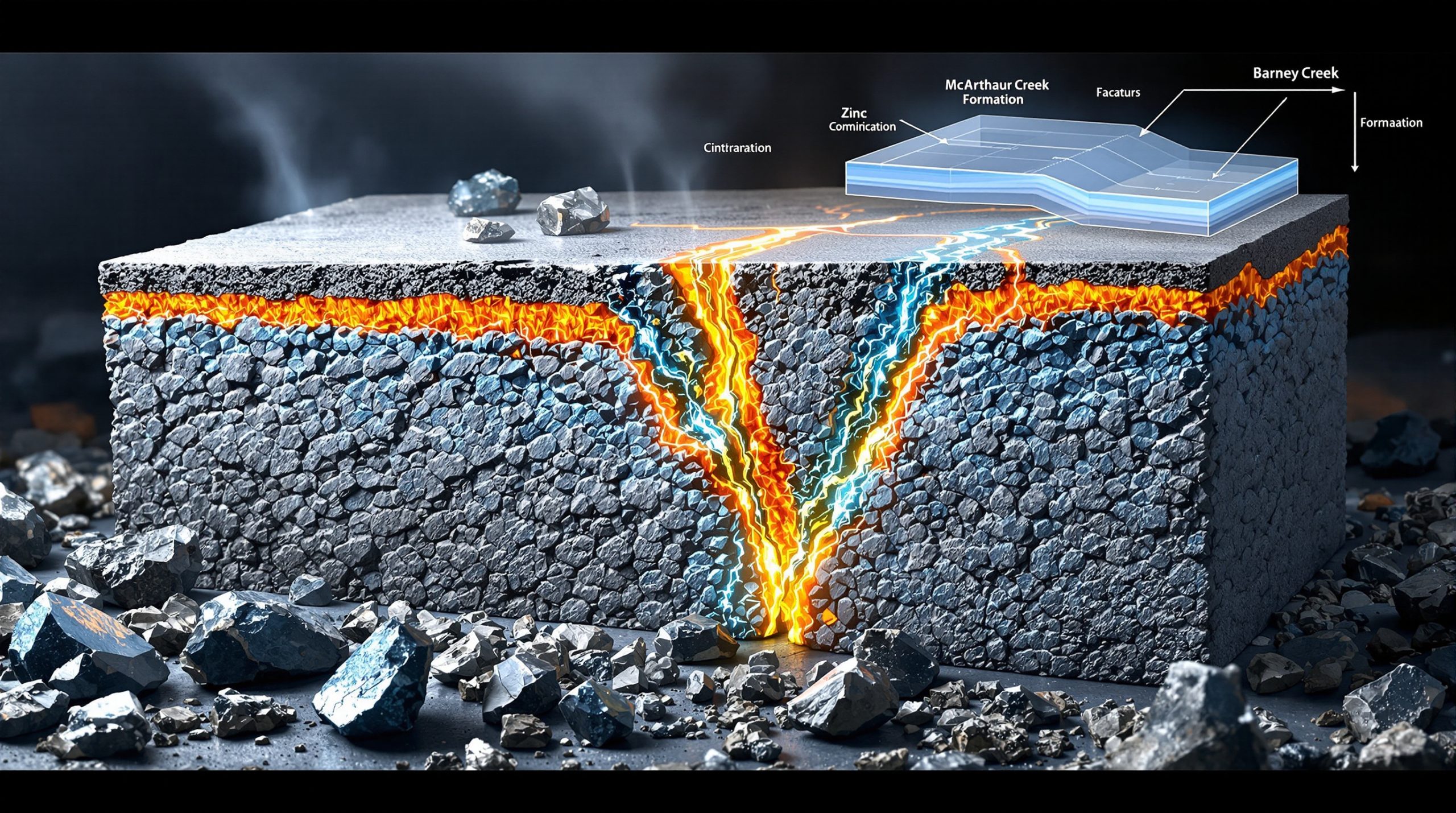Why Did Macquarie Lower Fortescue's Price Target? A Complete Analysis
Macquarie Group recently revised its stance on Fortescue Metals Group (ASX: FMG), downgrading the iron ore giant to "underperform" from its previous "neutral" position. Simultaneously, the broker reduced its 12-month price target to $15.50, representing a significant 20% potential downside from Fortescue's recent trading price of $19.34. This bearish outlook comes despite some positive operational metrics in Fortescue's latest financial results.
The downgrade follows Fortescue's FY2025 financial performance, which revealed a substantial 41% year-on-year decline in net profit after tax (NPAT) to US$3.4 billion. While this profit figure missed Macquarie's expectations by approximately 5%, the underlying EBITDA of US$7.9 billion actually exceeded the broker's forecasts by 2%.
Analysts point to a combination of company-specific concerns and broader iron ore price trends as driving factors behind this revised assessment. Industry experts note that commodity market volatility remains the dominant influence on Fortescue's financial outcomes, regardless of operational efficiency.
How Did Macquarie's Assessment of Fortescue Change?
Macquarie's downgrade represents a meaningful shift in its outlook for Fortescue. The reduction in price target from approximately $16.00 to $15.50 might seem modest at 3%, but the rating change from "neutral" to "underperform" signals significantly increased caution about the company's prospects over the coming year.
The broker acknowledged that Fortescue delivered "a relatively clean result that should provide investors confidence in delivery," yet still maintained its negative stance based on forward-looking concerns rather than historical performance.
Financial analysts note that Macquarie's position stands out because it focuses on potential iron ore market deterioration rather than company-specific operational issues. The broker specifically cited "expectations of an iron ore market pull-back across the next 12 months" as the primary justification for its underperform rating.
This assessment represents a more pessimistic view than some market participants hold, with Fortescue's relatively strong share price performance over the past year suggesting many investors remain confident about the company's prospects despite challenging market conditions.
What Drove Fortescue's 41% Profit Decline?
Fortescue's financial performance deteriorated substantially across multiple metrics in FY2025, creating a stark contrast with its operational achievements:
- Revenue declined 15% to US$15.5 billion
- Underlying EBITDA fell 26% to US$7.9 billion
- Net profit plummeted 41% to US$3.4 billion
- Operating cash flow decreased 18% to US$6.5 billion
- Free cash flow dropped 50% to US$2.5 billion
These financial setbacks occurred despite Fortescue maintaining robust operational performance, including achieving record iron ore shipments during the period. The company even managed to reduce its C1 cost of iron ore hematite by 1% to US$17.99 per wet metric tonne, reinforcing its position as the industry's lowest-cost producer.
Mining industry evolution experts note that this divergence between operational excellence and financial performance highlights a fundamental characteristic of commodity businesses—efficiency improvements can be overwhelmed by price movements beyond management control.
Financial analysts point out that iron ore price volatility remains the dominant influence on Fortescue's business outcomes, regardless of management's operational achievements. This price sensitivity creates an inherent challenge for investors trying to value the company based on operational metrics alone.
Why Is Macquarie Concerned About Fortescue's Dividend Strategy?
Fortescue's final dividend of 60 cents per share (down 32.6% from the prior year's final dividend) aligned with market consensus forecasts. However, Macquarie expressed concern that the full-year payout ratio of 65% fell below their expected 70% level.
According to Macquarie's analysis, this more conservative payout ratio suggests Fortescue's management and board anticipate potential risks in both capital expenditure requirements and iron ore price environment. The broker explicitly stated: "Although FMG delivered in-line financials, a 65% pay-out ratio, in our view, indicates management and the board see risk in the capex and price outlook."
Dividend investment specialists note that this interpretation suggests Fortescue's leadership may be preparing for challenging market conditions by retaining additional capital flexibility. The company's dividend policy has historically been generous, making any shift toward conservatism particularly noteworthy.
Financial analysts point out that dividend payout ratios often serve as a signal of management's confidence in future cash flows. A reduction in payout ratio, even a modest one, can therefore be interpreted as indicating increased caution about future business conditions.
What Capital Expenditure Concerns Does Macquarie Highlight?
Macquarie specifically flagged concerns about Fortescue's future capital expenditure requirements, noting the company's commentary around increased sustaining capital needs for fleet replacements. While Fortescue has not provided specific guidance beyond FY2026, Macquarie projects that "hub replacements and decarbonisation [will] keep spend at ~US$4.0b until FY30."
This substantial ongoing capital commitment represents a significant claim on Fortescue's cash flows, potentially limiting dividend growth even if iron ore prices stabilize or improve. The broker's analysis suggests these capital requirements will remain elevated for several years, creating persistent pressure on the company's free cash flow generation.
Mining industry experts note that capital intensity in iron ore mining has been increasing industry-wide, as companies deplete easier-to-access ore bodies and must invest more heavily in infrastructure, transportation, and processing facilities to maintain production levels.
Resource sector specialists point out that decarbonization initiatives represent a relatively new capital requirement for mining companies, adding to traditional sustaining and growth capital needs. Fortescue has been particularly aggressive in its green energy commitments, potentially increasing its capital requirements compared to peers.
What Is Macquarie's Iron Ore Market Outlook?
The primary driver behind Macquarie's downgrade appears to be its pessimistic view on iron ore markets over the coming year. The broker explicitly cited "expectations of an iron ore market pull-back across the next 12 months" as the key justification for its underperform rating.
This bearish outlook reflects concerns about:
- Chinese steel demand sustainability, particularly in the construction sector
- Potential supply increases from major producers globally
- Inventory management strategies among Chinese steel mills
- Broader economic headwinds affecting industrial commodity demand
Commodity market analysts note that Chinese property sector challenges have created significant uncertainty about future iron ore demand insights. With China consuming approximately 70% of global seaborne iron ore, any softening in Chinese construction activity has outsized impacts on the market.
Resource market specialists point out that iron ore supplies have been relatively constrained in recent years due to production disruptions in Brazil and weather events in Australia. Any normalization of these supply conditions could create downward pressure on prices, even without demand deterioration.
Macquarie's iron ore forecast 2025 projections appear significantly more conservative than current spot prices, suggesting the broker anticipates substantial downside risk to the commodity that forms the backbone of Fortescue's business model.
How Does Fortescue's Financial Outlook Compare to Historical Performance?
Analyst projections for Fortescue paint a concerning picture of deteriorating financial metrics over the coming years:
- Revenue is projected to decline at a compound annual growth rate of -6% over the next four years, compared to +13% growth over the previous eight years
- Operating income faces an even steeper projected decline of -22% annually over the next four years, versus +21% growth historically
- Net income is expected to contract at -19% annually, a stark reversal from the +25% growth achieved previously
These projections reflect the challenging market environment Fortescue faces and align with Macquarie's cautious stance on the company's prospects.
Financial analysts note that this reversal of fortune represents a significant inflection point in Fortescue's business trajectory. The company's historical growth was driven by both production increases and favorable commodity prices, but future growth opportunities appear more limited.
Mining industry specialists point out that Fortescue's operational improvement potential also faces constraints, as the company has already achieved industry-leading cost positions. With limited further efficiency gains available, revenue and profit growth becomes heavily dependent on favorable iron ore prices.
How Has Fortescue's Share Price Performed Recently?
Fortescue shares have demonstrated notable volatility following the company's earnings announcement:
- Shares fell 3.9% on the day of the FY2025 results release
- They dropped another 0.8% the following day
- A 1.47% recovery occurred on the third day, bringing the share price to $19.34
Despite these fluctuations, Fortescue shares have managed to deliver approximately 5% capital appreciation over the past year. When combined with the $1.10 per share in fully franked dividends paid during the period, total shareholder returns have been reasonably positive despite the challenging operating environment.
Market analysts note this resilience in Fortescue's share price, despite deteriorating financial metrics, may partially explain Macquarie's concern about valuation disconnecting from fundamentals. The stock appears to be trading on sentiment and income characteristics rather than pure earnings growth potential.
Investment strategists point out that high-dividend resource stocks often attract yield-focused investors who may be less sensitive to growth metrics, potentially supporting share prices even during periods of earnings pressure. This dynamic can create valuation disparities that eventually correct through price adjustments.
What Are Other Analysts Saying About Fortescue?
The broader analyst community shows divided opinions on Fortescue's outlook:
- Wall Street analysts maintain an average 12-month price target of $17.70, with forecasts ranging from $15.66 to $21.00
- Bell Potter recently downgraded Fortescue to "sell" with a price target of $17.05
- Citigroup provides a contrasting view, upgrading Fortescue from "hold" to "strong-buy"
This diversity of opinions highlights the uncertainty surrounding iron ore markets and Fortescue's strategic positioning. Macquarie's $15.50 target sits at the lower end of the analyst range, reflecting its more bearish outlook compared to peers.
Investment professionals note that this wide dispersion in analyst price targets indicates genuine uncertainty about Fortescue's prospects. The range from $15.50 to $21.00 represents approximately 35% difference between lowest and highest targets, an unusually large spread for a major ASX company.
Market strategists point out that analyst disagreements often center on differing views about commodity price trajectories, which remain inherently difficult to forecast accurately. Given Fortescue's high sensitivity to iron ore prices, different price assumptions can lead to dramatically different valuation conclusions.
What Potential Catalysts Could Change Macquarie's Outlook?
Despite its overall negative stance, several potential positive catalysts could support Fortescue's share price and potentially lead to a revision in Macquarie's outlook:
- Improved performance at the Iron Bridge operation, which has faced ramp-up challenges
- Stronger-than-expected iron ore prices, particularly if Chinese stimulus measures boost steel demand
- Better capital allocation decisions that reduce projected expenditure levels
- Cost reduction initiatives that further strengthen Fortescue's industry-leading cost position
Mining industry experts note that Iron Bridge represents an important growth initiative for Fortescue, producing higher-grade magnetite concentrate that can command premium pricing in a market increasingly focused on environmental performance.
Resource market specialists point out that Chinese government policy remains a crucial wild card for iron ore markets. Any significant infrastructure stimulus package or property sector support could rapidly change demand dynamics and strengthen prices.
However, Macquarie clearly believes these potential positive developments are outweighed by the broader market risks and valuation concerns in its current assessment.
How Significant Is Fortescue's Dividend for Investors?
For income-focused investors, Fortescue's dividend remains a crucial consideration despite Macquarie's concerns:
- The final dividend of 60 cents per share is still available to investors who purchase shares before the ex-dividend date (September 1, 2025)
- The full-year dividend of $1.10 per share represents a 65% payout ratio of NPAT
- At current share prices, this dividend yield remains attractive compared to broader market averages
Income investment specialists note that Fortescue's dividend policy has historically been among the most generous in the ASX 200, making it a favorite among yield-focused investors. This investor base provides some support for the share price independent of growth prospects.
Financial advisors point out that fully franked dividends from Australian resource companies offer particular tax advantages to domestic investors, potentially making them more valuable than equivalent unfranked yields from other sectors or international investments.
However, Macquarie's analysis suggests this dividend level may face pressure in future periods if iron ore prices decline as expected and capital expenditure requirements remain elevated.
What Are the Implications for Fortescue's Green Energy Initiatives?
Fortescue has made substantial investments in decarbonization efforts, allocating $405 million (approximately 10% of total capital expenditure) to these initiatives in FY2025. However, Macquarie's commentary suggests some skepticism about the near-term financial returns from these investments.
The broker previously noted that Fortescue enjoyed an implied $5 per share premium over iron ore peers such as BHP and Rio Tinto, primarily attributed to investor valuation of the company's green energy initiatives. However, Macquarie warns Fortescue restructure could erode share price premium as the company's green energy strategy evolved and market participants gained greater clarity about implementation timelines and financial returns.
Energy transition specialists note that Fortescue has pursued a particularly ambitious decarbonization strategy compared to mining industry peers, creating both opportunities and risks. The company's investments in green hydrogen, renewable energy, and electrification technologies position it uniquely in the sector.
Investment analysts point out that market sentiment toward green initiatives can shift rapidly based on broader economic conditions and commodity price environments. During periods of strong profitability, investors tend to support substantial investments in sustainability initiatives, but this tolerance may diminish during challenging market conditions.
The substantial ongoing capital requirements for both traditional mining operations and green energy initiatives create potential tensions in capital allocation that may pressure Fortescue's financial flexibility during periods of weaker iron ore prices.
Conclusion: Is Macquarie's Downgrade Justified?
Macquarie's downgrade of Fortescue to "underperform" with a $15.50 price target reflects a comprehensive assessment of both company-specific factors and broader market dynamics. The broker's concerns center on:
- Expected weakness in iron ore markets over the next 12 months
- Elevated capital expenditure requirements through FY2030
- Potential pressure on dividend sustainability
- Valuation levels that appear disconnected from fundamental outlook
While Fortescue continues to demonstrate operational excellence as the industry's lowest-cost producer, Macquarie's analysis suggests these advantages may be insufficient to offset the anticipated headwinds from commodity price pressures and capital allocation requirements.
For investors considering Fortescue shares, the key question becomes whether they share Macquarie's bearish outlook on iron ore markets or believe the broker is being overly pessimistic about the commodity's price trajectory. The answer to that question will largely determine whether Fortescue represents value at current levels or faces the 20% downside that Macquarie's price target implies.
Market analysts note that commodity-related investments frequently face valuation challenges because short-term price movements can overwhelm even the strongest operational fundamentals. This creates opportunities for contrarian investors willing to take positions against prevailing market sentiment.
Investment strategists suggest that income-oriented investors may find Fortescue attractive despite growth concerns, particularly if they believe the dividend can be maintained through the market cycle. Conversely, growth-focused investors may prefer to heed Macquarie's earnings result assessment until greater clarity emerges about iron ore market direction.
Ultimately, Fortescue's share price performance over the coming year will likely be determined more by iron ore price movements than by company-specific factors, making market timing a crucial consideration for potential investors.
Ready to Gain Insights on Future Mining Discoveries?
Discover how you can identify high-potential mining opportunities before they hit mainstream attention with Discovery Alert's proprietary Discovery IQ model. Visit our discoveries page to see how historic mineral discoveries have generated exceptional returns for early investors.




